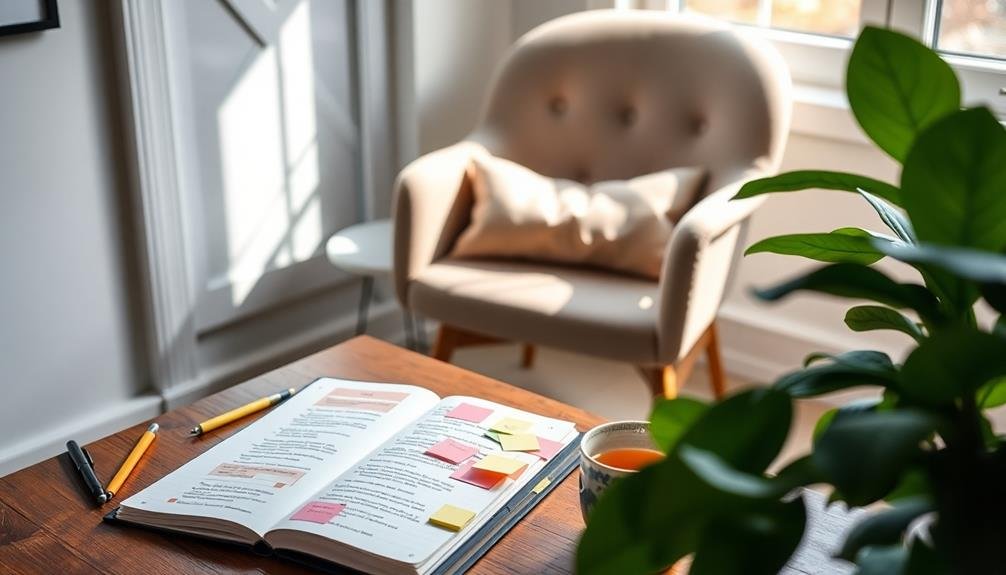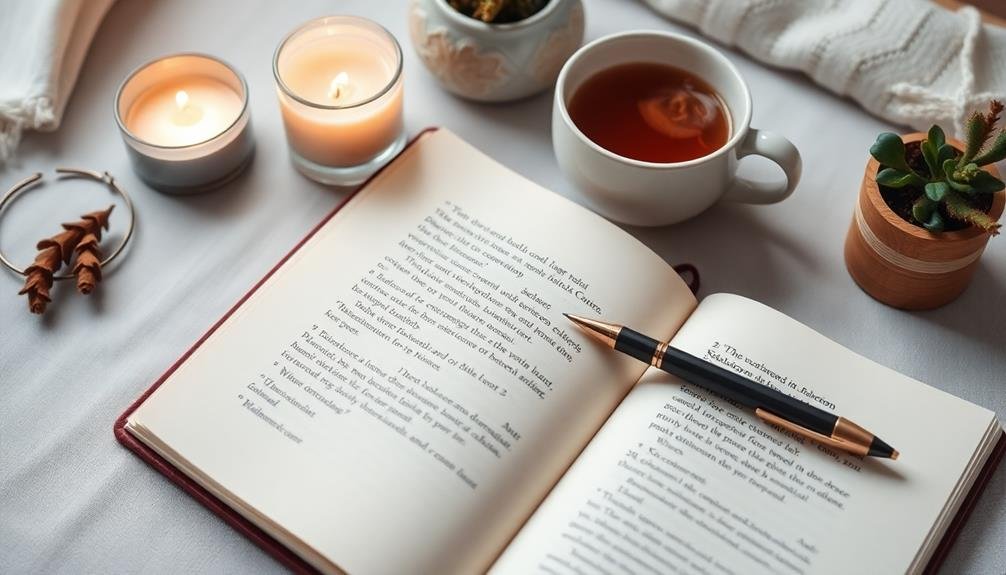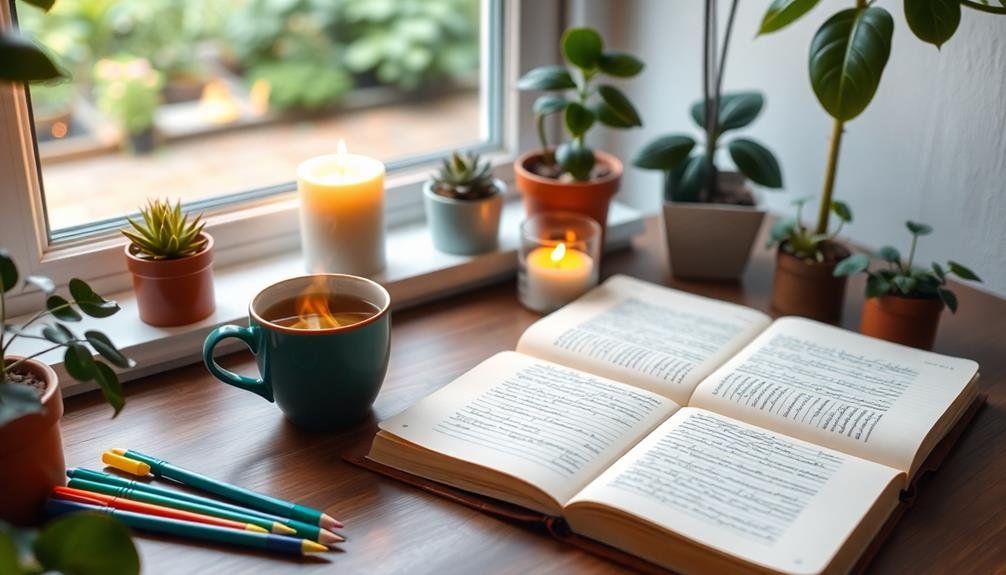Journaling is a powerful stress-relief toolkit for managing anxiety. It gives you a safe space to express your thoughts and emotions, helping you to process and externalize feelings that might otherwise feel overwhelming. By identifying patterns and triggers, you enhance your self-awareness, allowing you to tackle anxiety more effectively. You can explore different techniques like gratitude journaling or free writing to find what resonates with you. Creating a comfortable writing environment is essential too. Once you establish a routine, you'll notice how journaling fosters mindfulness and personal growth, leading to a greater sense of control over your emotions. Discover even more ways to enhance your practice.
Benefits of Expressive Writing

Expressive writing can be a powerful tool for managing anxiety. When you write down your thoughts and feelings, you create a safe space to explore your emotions without judgment. This process allows you to articulate what's bothering you, which can help you understand your anxieties better.
By putting pen to paper, you're not just venting; you're actively processing your experiences. You can identify patterns in your thoughts and feelings, leading to greater self-awareness. This clarity helps you figure out what triggers your anxiety, empowering you to take steps to address these issues.
Expressive writing also acts as a release valve for pent-up emotions. When you let your thoughts flow freely, you may find that your anxiety lessens as you unload your burdens. You'll likely feel lighter, more in control, and better equipped to face challenges.
Additionally, the act of writing can be meditative. It encourages mindfulness, grounding you in the present moment. As you focus on your writing, you divert attention from anxious thoughts, allowing your mind to relax.
Embrace expressive writing as a valuable tool in your anxiety management toolkit.
How Journaling Reduces Anxiety
Journaling helps you release pent-up emotions, giving you a safe space to express what's bothering you.
This emotional release can lighten your mental load and reduce anxiety levels.
Plus, as you write, you enhance your self-reflection skills, allowing you to better understand your thoughts and feelings.
Emotional Release Mechanism
Writing down your thoughts acts as a powerful emotional release mechanism, helping to alleviate anxiety. When you put pen to paper, you create a safe space to express your feelings without judgment. This process allows you to externalize your thoughts, making them less overwhelming. Instead of keeping everything bottled up, you're giving yourself permission to vent.
As you write, you may find clarity in your emotions. You can identify what's truly bothering you, whether it's a specific event or a lingering worry. By articulating these feelings, you break the cycle of ruminating thoughts that often fuel anxiety. Journaling also serves as a form of catharsis; releasing pent-up emotions can lighten your mental load.
Additionally, you can explore various writing styles—free writing, lists, or prompts—to express yourself. This flexibility encourages you to discover new ways to cope with stress. Each session can feel like a mini therapy session, allowing you to confront your emotions head-on.
The act of journaling not only reduces anxiety but also empowers you to take charge of your feelings, paving the way for a more peaceful mindset.
Enhanced Self-Reflection Skills
Through the act of putting your thoughts on paper, you can considerably enhance your self-reflection skills, which in turn helps reduce anxiety. When you journal, you create a safe space to explore your feelings and thoughts without judgment. This practice allows you to identify patterns and triggers that contribute to your anxiety. As you write, you might discover underlying beliefs or fears that you weren't fully aware of before.
By regularly reflecting on your entries, you gain deeper insights into your emotional responses. You start to understand what situations make you anxious and why. This awareness empowers you to challenge your negative thoughts and replace them with more constructive ones.
You'll notice that, over time, you're better equipped to handle stressors as you learn to anticipate and navigate them more effectively.
Additionally, journaling helps you track your progress. You can see how your thoughts evolve and how you cope with challenges. This clarity not only alleviates anxiety but also builds your confidence in managing your emotions.
Different Journaling Techniques

A blank page can become a powerful tool for managing anxiety when you explore different journaling techniques. One effective method is free writing, where you set a timer for 10-15 minutes and write whatever comes to mind without worrying about grammar or structure. This technique helps you release pent-up thoughts and feelings.
Another approach is gratitude journaling. Each day, jot down three things you're thankful for. This shifts your focus from anxiety to positivity, helping to create a more balanced mindset.
You might also try bullet journaling, which combines planning with journaling. Use symbols or short phrases to track your moods, goals, and daily tasks, giving you a visual representation of your emotions.
If you prefer structure, try prompts. Write about your biggest fear or a challenging situation and how you handled it. This reflection can deepen your understanding of your anxiety triggers.
Creating a Safe Writing Space
Creating a safe writing space is essential for effective journaling. You need to choose a location where you feel comfortable, gather the right materials, and set a routine that works for you.
Choose Your Location
While finding the right spot to journal might seem trivial, it can greatly impact your ability to express yourself and manage anxiety. Choosing a location that feels safe and comfortable is essential for effective journaling. Look for a space where you won't be interrupted, allowing your thoughts to flow freely without distractions. Whether it's a cozy corner of your home, a quiet park, or a favorite café, pick a place that resonates with you.
Consider the ambiance of your chosen location. Soft lighting, minimal noise, and a calm atmosphere can create a peaceful setting that helps you relax. You might prefer a spot with natural elements, like a view of trees or flowers, which can also promote tranquility.
It's important to think about your physical comfort as well. Make sure you have a comfortable chair or spot to sit, and keep your writing materials easily accessible.
The more inviting and comforting your journaling space is, the more likely you'll want to return to it regularly. By intentionally selecting your location, you create an environment conducive to self-reflection and stress relief, allowing your anxiety to dissipate as you write.
Gather Writing Materials
Gathering the right writing materials is essential for establishing a safe and inviting journaling space. Start with a notebook that feels comfortable in your hands. Whether it's lined, blank, or dotted, choose one that inspires you to write. You might prefer a physical journal or a digital app—go with what suits your style.
Next, select writing tools that bring you joy. A smooth pen, colorful markers, or even a pencil can make a difference in your experience. Experiment with different options until you find what encourages you to express your thoughts freely.
Consider adding some extras to enhance your space. Stickers, washi tape, or highlighters can make your journaling more enjoyable and visually appealing.
A cozy blanket or a cushion can also help create a comfortable atmosphere, allowing you to feel relaxed and safe.
Set a Routine
Establishing a consistent routine for journaling can greatly enhance your anxiety management practice. By setting aside dedicated time each day, you create a safe space where you can reflect and express your thoughts. Choose a time that works best for you, whether it's in the morning to set a positive tone for the day or at night to unwind.
Next, find a comfortable and quiet spot to write. This space should be free from distractions, allowing you to focus on your thoughts and feelings. Make sure it's well-lit and inviting, perhaps with your favorite blanket or a cozy chair.
Having a consistent writing environment can help signal your brain that it's time to relax and reflect.
Additionally, consider incorporating a ritual before you write. This could be lighting a candle, brewing a cup of tea, or playing soft music. These small actions help you shift into your journaling session, making it feel more intentional and calming.
Prompts to Get Started

Accessing your thoughts through journaling can be a powerful tool for managing anxiety. It allows you to articulate your feelings and identify triggers. If you're unsure where to start, prompts can provide the guidance you need.
Here are some ideas to kick off your journaling journey:
- What's weighing on my mind right now? Write about the thoughts that are causing you stress.
- What am I grateful for today? Focusing on gratitude can shift your perspective.
- How do I feel in this moment? Describe your current emotions without judgment.
- What's one thing I can do to improve my day? Think about actionable steps you can take.
- What are my fears, and how can I address them? Explore your fears and consider ways to confront them.
These prompts not only help you explore your thoughts but also create a safe space for emotional expression.
Incorporating Mindfulness in Journaling
Journaling can become even more effective when you incorporate mindfulness into your practice. By being present in the moment while you write, you can deepen your self-awareness and enhance your emotional processing.
Start by creating a quiet, comfortable space where you can focus solely on your thoughts and feelings. As you begin to write, pay attention to your breath. Inhale deeply and exhale slowly, grounding yourself in the here and now.
When you sit down to journal, set an intention for your session. Perhaps you want to explore a specific emotion or reflect on your day. Allow your thoughts to flow freely without judgment. If your mind wanders, gently bring your focus back to your writing and the sensations around you.
Try incorporating sensory details into your entries. Describe the sights, sounds, and smells in your environment to anchor yourself in the present. This practice not only enriches your journaling experience but also cultivates gratitude and mindfulness.
Overcoming Writer's Block

Sometimes, you might find yourself staring at a blank page, feeling stuck and frustrated.
Writer's block can be a common hurdle in your journaling journey, but don't let it derail your progress. There are several techniques you can use to spark your creativity and get the words flowing again.
- Freewrite: Set a timer for 5-10 minutes and write whatever comes to mind. Don't worry about grammar or structure; just let your thoughts spill onto the page.
- Prompts: Use journaling prompts to kickstart your writing. Questions like "What made me smile today?" can guide your thoughts.
- Change Your Environment: Sometimes a change of scenery can inspire new ideas. Try writing in a park, café, or a different room.
- Visuals: Incorporate doodles, images, or quotes that resonate with you. Visual elements can ignite new thoughts.
- Take Breaks: If you're feeling overwhelmed, step away for a moment. A brief walk or relaxation can refresh your mind.
Maintaining a Consistent Practice
Finding your flow again after experiencing writer's block is just the first step. To truly benefit from journaling as a tool for anxiety management, you need to maintain a consistent practice. Set aside dedicated time each day or week for your journaling sessions.
Whether it's morning reflections or evening wind-downs, find a routine that fits your lifestyle. Start small; even five minutes a day can make a difference. As you write, don't pressure yourself to produce perfect sentences or profound insights. Just let your thoughts flow.
If you miss a day or two, don't be hard on yourself. Acknowledging that life can get busy is part of the process. Instead, gently reintroduce journaling into your routine.
Consider keeping your journal accessible. Place it by your bedside or in your bag so you can jot down thoughts whenever inspiration strikes. You might also explore prompts or themes to keep your practice engaging.
Frequently Asked Questions
Can Journaling Be Beneficial for Children With Anxiety?
Yes, journaling can be beneficial for children with anxiety. It helps them express their feelings, process thoughts, and develop coping strategies. By writing regularly, they can gain clarity and reduce overwhelming emotions, fostering resilience.
How Often Should I Journal for Effective Stress Relief?
You should journal regularly to see effective stress relief. Aim for at least a few times each week, but listen to your feelings. Adjust the frequency based on what helps you feel most balanced and calm.
What Materials Do I Need to Start Journaling?
To start journaling, you'll need a notebook or journal, a pen or pencil, and a quiet space. Optional items include colored pens, stickers, or prompts to spark your creativity and enhance your writing experience.
Can I Use Digital Tools for Journaling?
Absolutely, you can use digital tools for journaling! Apps and online platforms offer convenience and flexibility. You can easily access your thoughts anytime, anywhere, and even incorporate multimedia elements to enhance your journaling experience.
Is There a Specific Time of Day Best for Journaling?
The best time for journaling depends on you. Some find morning reflections energizing, while others prefer evening to unwind. Experiment with different times and notice when you feel most inspired and relaxed to write.
In Summary
Journaling can be a powerful tool for managing anxiety and finding relief from stress. By embracing different techniques and creating a safe space to write, you can access your thoughts and feelings. Remember, there's no right or wrong way to journal—just let your words flow. With practice, you'll not only enhance your emotional well-being but also develop a deeper understanding of yourself. So grab that pen, start writing, and take the first step toward a calmer mind.





Leave a Reply